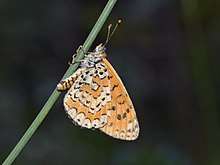Melitaea trivia
Melitaea trivia, the lesser spotted fritillary, is a butterfly of the family Nymphalidae, part of the sub-family Nymphalinae. It is found in the southern part of the Palearctic ecozone. In Europe it is sometimes called the desert fritillary, but this name also refers to the North African relative M. deserticola.
| Melitaea trivia | |
|---|---|
 | |
| Scientific classification | |
| Kingdom: | Animalia |
| Phylum: | Arthropoda |
| Class: | Insecta |
| Order: | Lepidoptera |
| Family: | Nymphalidae |
| Genus: | Melitaea |
| Species: | M. trivia |
| Binomial name | |
| Melitaea trivia | |
It was first described in 1775 by entomologists Michael Denis and Ignaz Schiffermüller under the basionym Papilio trivia.[1]
The wingspan is 15–23 mm. At first sight it is somewhat similar to Melitaea didyma but the black lunules before the margin united and the disc traversed by a strongly flexuose macular band, the hindwing with abundant, connected, black markings on the disc. The female with the ground-colour centrally more or less pale, especially on the forewing.[2].
The larvae feed on Verbascum species.
Sub-species
- Melitaea trivia catapelia Staudinger, 1886
- Melitaea trivia caucasi Verity, 1922
- Melitaea trivia chorosana Shchetkin, 1984
- Melitaea trivia fascelis (Esper, 1783) – in the south of Europe
- Melitaea trivia ignasiti Sagarra, 1926 – in the Iberian Peninsula. This taxon tends to be considered as the distinct species : Melitaea ignasiti.
- Melitaea trivia nana Staudinger, 1871
- Melitaea trivia nativa Tuzov, 2000
- Melitaea trivia petri Shchetkin, 1984
- Melitaea trivia singularia Korshunov, 1995
- Melitaea trivia uvarovi Gorbunov, 1995[1]
Common names
- In German: Braunlicher Scheckenfalter
- In French: Mélitée du bouillon-blanc
- In English: Lesser Spotted Fritillary or Desert Fritillary[1]
References
- "Melitaea trivia". funet.fi. Retrieved 5 February 2019.
- Seitz. A. in Seitz, A. ed. Band 1: Abt. 1, Die Großschmetterlinge des palaearktischen Faunengebietes, Die palaearktischen Tagfalter, 1909, 379 Seiten, mit 89 kolorierten Tafeln (3470 Figuren)
